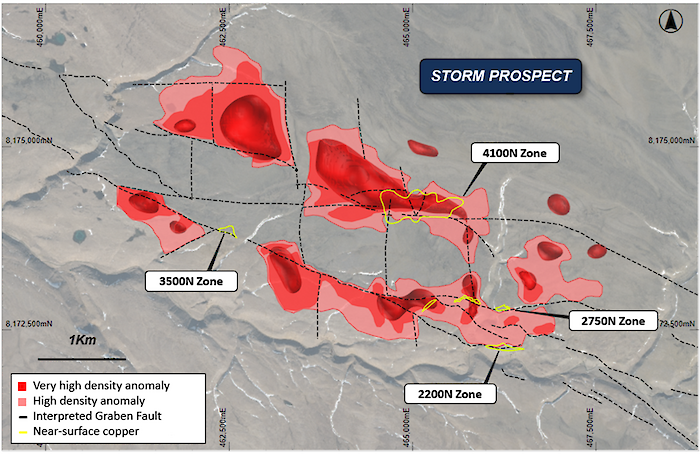rarity of projects like Storm Copper 4100N ZONE – TIP OF THE ICEBERG?
The new drill hole data at the 4100N Zone is helping to further the understanding of the geological setting and mineralization processes of the Storm copper system. The drilling is revealing a laterally extensive zone of mineralization that displays many of the features of a typical sediment hosted copper deposit, including multiple stacked copper horizons. The recent gravity survey data has highlighted a large and dense body underneath the 4100N Zone (see June 9, 2023 news release) which is interpreted to potentially represent a larger accumulation of copper sulfides (Figure 5).
Importantly, the geology of the 4100N displays marked similarities to that observed in drilling that has tested deeper parts of the system. Drill hole ST22-10, drilled to the west and below the stratigraphic level of the 4100N Zone, targeted a large EM anomaly and intersected 68 m of a typical sediment hosted mineral assemblage including chalcopyrite, pyrite, sphalerite, and galena. At the 4100N Zone and elsewhere at Storm, this mineral assemblage is located peripheral to a larger and higher-grade core dominated by chalcocite, bornite and covellite.
The geological similarities and spatial association between the 4100N Zone and ST22-10 suggest that the two types of mineralization may be related and form part of a large, stacked copper system hosted in several prospective stratigraphic horizons (Figure 6).

Figure 5: Gravity data interpretation map showing the 3D gravity targets, zones of known near-surface copper
sulfide mineralization and major faults (overlaying topography).

Figure 6: Conceptual geological and exploration targeting model for the Storm Project,
showing depth of current drilling and conceptual location of discovery drill hole ST22-10.
EVIDENCE OF A MAJOR COPPER SYSTEM
The drilling and geophysical evidence strongly support the potential for a large-scale copper system within the Storm Project area.
The geology of the area displays all the elements required in the sediment-hosted mineralizing process: permeable carbonate rocks to act as a fluid conduit and host mineralization, hydrocarbons to reduce metal-bearing fluids and force metal precipitation, sulfur source from bitumen and sour gas, proximity to faults known to be an effective source for plumbing, all within a favourable structural setting.
A distinct zonation of metal and mineralogy is also observed at Storm. The zonation appears as a large copper-rich core (chalcocite, bornite and covellite) that gives way laterally and vertically to thinner peripheral zones of copper-iron (chalcopyrite), iron (pyrite), zinc (sphalerite) and minor lead (galena). This zonation provides a powerful vector for exploration.
These key features are similar to many of the world’s major sediment-hosted copper systems, including the deposits of the Kalahari Copper Belt (Botswana) and Central African Copper Belt (DRC, Zambia).